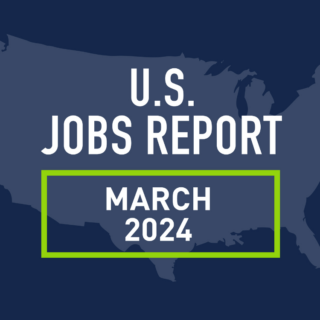Automation is transforming the way we work. The World Economic Forum calls this change the Fourth Industrial Revolution which is characterized by a “fusion of technologies that is blurring the lines between the physical, digital and biological spheres.” In short, technology is disrupting nearly every industry, at a pace that has never happened before.
This pace of change means that employers need to take a proactive role in ensuring they have a workforce equipped with the skills of the future in order to avoid skills gaps. To accomplish this, employers first need to understand the skills they will need to remain competitive and innovative. Then, they need to understand how best to prepare and train their current workforce, as well as prepare to source, recruit and hire the talent of the future. In this post, we’ll share the top skills of the future, how technology is changing the way we work and explore ways organizations can prepare for the workforce of the future.
Skills of the Future
According to the World Economic Forum, the top ten skills you need to thrive in the Fourth Industrial Revolution have shifted in the last several years, prioritising complex problem solving, critical thinking and creativity as the top three skills and adding emotional intelligence to the list.
The following ten skills are listed as the most in demand for employers:
- Complex problem solving
- Critical thinking
- Creativity
- People management
- Coordinating with others
- Emotional intelligence
- Judgment and decision making
- Service orientation
- Negotiation
- Cognitive flexibility
This list reflects the fact that robots can complete many tasks faster than humans, but the machines still lack soft skills like creativity and emotional intelligence. As technology takes on more of the workload, the most in-demand employees will be those who possess the skills that computers cannot replicate. However, the need also increases for workers who have the skills to use, build and innovate the technology of the future.
Automation is Changing the Way We Work
It’s no secret that automation is fundamentally changing the way many industries operate, increasing the demand for tech and digital skills in the workforce. According to the McKinsey Global Institute, as many as 375 million people around the world will need to change occupational categories by 2030 due to automation.
Let’s explore this idea using the example of the impact of automation on the automobile industry. Some of the most well-known innovations in automation have happened in the industry – starting with Henry Ford’s assembly line. Now, companies around the world are racing to bring autonomous cars to market. The link to the potential disruption in complementary industries from delivery services to drive-through restaurants is overwhelming. However, it is an excellent example to use to illustrate the complexity of the skills needed for the future.
The skills required to deliver the cars to market are both highly technical and analytical. However, the skills needed to design and operate the vehicles of the future are more complicated. Skills in design thinking and innovation will be critical. Programmers will need to ensure safety in weather conditions from blizzards to heavy rains and navigate autonomous cars and trucks through road construction and complicated intersections and interchanges. They may be faced with programming life and death decision-making into the vehicles, which are inherently complex human behaviours requiring emotional and social intelligence skills above all others.
How to Prepare the Future Workforce
The Transformation of Talent
Automation and the skills transformation will affect many industries over the next decade, but lessons can be learned from the industries that have already come through the journey, transforming their workforce in order to deliver to a new business model. This transformation is illustrated with an example of one of PeopleScout’s clients, a company which provides research and risk management services.
The company began migrating customers from the traditional print version of their core product to an online version available on multiple platforms. This was a complicated and highly-involved transformation which impacted everyone from their internal workforce to their heavily print-dependent end-user. To illustrate the skills transformation that occurred, since that point in time, the number of technology hires PeopleScout makes for this client has increased 500 percent. This includes roles like product analysts, product managers and implementation consultants. At the same time, hires for editorial roles like editors, journalists and content developers have increased only 14 percent. And, 100 percent of editorial roles filled were for their online research product; no positions filled were for the traditional print product.
In order to help guide this client through their talent transformation, PeopleScout worked closely with the internal HR function to adapt their candidate personas for both external hiring and internal mobility. We then developed sophisticated sourcing strategies to source candidates with skill sets that would meet the needs of the new organization. In addition to sourcing new candidates internally and externally, there were also efforts to analyze which traditional roles had transferrable skills to the requirements of the new roles. This was a journey to take a traditional business and transform it into a technology company and substantially shifting the workforce to meet the new strategy.
Future Skill Degree Programs
Another way employers can prepare for the future workforce is through working closely with high schools, colleges, universities, apprenticeships and graduate recruitment programs to help develop degree programs that meet the skills of the future. By building these programs, employers can ensure that graduates have the skills necessary to succeed in the coming years.
The importance of high school programs is not yet as obvious as those in higher education, but many businesses and universities have started working with high schools to source and attract new talent early. The programs are particularly significant in industries where there is a forecasted talent gap. For example, Monte Sant’ Angelo Mercy students in Sydney have the opportunity to partner with an engineering company to learn valuable job skills and open up thinking about new career pathways.
I recently participated in a panel discussion with other industry leaders as well as a professor at a university in Sydney. The professor shared that the university spent time with CEOs and business leaders asking them what skills they felt their organizations needed to ensure their business was successful in the future. As a result of those conversations, the university created a highly-innovative, cross-disciplinary degree program designed to produce students with skills that include high-level critical thinking, future scenario building and innovation, as well as many other skills identified in the World Economic Forum top ten list.
However, in the first year of the program, they had minimal applicants. Why would such an innovative and carefully-designed degree have so little applicants? More work may need to be done to ensure that parents and students are fully educated on the necessary skill sets to be successful in the future of work.
How to Prepare your Current Workforce
Employers cannot simply wait for the workforce of tomorrow to arrive. To stay ahead, it is necessary to train and prepare current workers for these shifts. To make this a priority, HR and the C-suite need to be aligned on what roles will be needed in the next three, five or ten years, as well as what skills will be needed to fill those roles. The roles that exist now may transform or disappear altogether, and new skill sets will be necessary for the business to drive growth and strategy. Both need to be open-minded about the transferrable skills in order to ensure success in having the talent to deliver key business outcomes.
Reskilling Programs
In some countries, governments have taken on some of the burden of reskilling. For example, the Australian government has established the Skilling Australians Fund which provides $1.5 billion to support apprenticeships, traineeships and other employer-related training. The goal is to retrain more Australian workers with the skills needed in the tourism, hospitality, health, engineering, manufacturing, building and construction, agriculture and digital technologies industries. The program is targeted toward automotive workers who lost jobs due to closing car manufacturing plants.
In the United Kingdom, the government plans to spend as much as 500 million pounds per year on worker training to combat low productivity. According to Reuters, the spending could reach as high as nearly 6 billion pounds on academic and technical education which will transform the system of technical education and increase the amount of training available by more than 50 percent.
Moving forward, governments could also potentially track metrics around reskilling opportunities as well as metrics for job creation in order to drive these initiatives even further forward.
How an RPO Provider Can Help Prepare for the Skills of the Future
An RPO provider can be a valuable partner for employers looking to prepare their workforces for the skills of the future. RPO providers can help organizations adapt their candidate personas, to ensure they are sourcing talent with the necessary skills and identifying new ways to target candidates who fit these personas. In addition, they can work with internal HR departments to demonstrate how candidates who may not have an exact profile for a role have the transferrable skills to be successful.
An RPO can also help build graduate and internship recruitment programs and partner with schools and government programs to find candidates from new sources with new skills.
An experienced RPO provider can also help you build your talent pool from within your own company, by consulting to develop an internal reskilling program and helping reevaluate your current positions and workforce mix to ensure your organization is targeting the right talent.
To stay ahead in the rapidly changing talent landscape, employers should evaluate their current workforce needs, the skills they have within their current employee talent pool and seek out an RPO provider who can act as a partner in sourcing, recruiting and training employees with the skills of the future.


![[On-Demand] AI in Recruiting: Hype, Ethics & Best Practices](https://www.peoplescout.com/wp-content/uploads/2024/03/ai-webinar-1-320x320.jpg)
